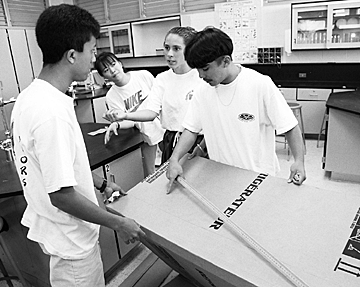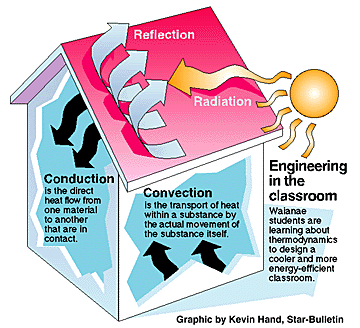
David Loto, Luyi Liu, Shantell Rodrigues and Alton Exzabe begin work on a model of their portable classroom. Photo by Craig Kojima, Star-Bulletin

David Loto, Luyi Liu, Shantell Rodrigues and Alton Exzabe begin work on a model of their portable classroom. Photo by Craig Kojima, Star-Bulletin
By Burl BurlingameRadiation, conduction and convection
are the key words as Waianae High
students design classrooms that have
more bearable temperatures
 "They kept measuring the dimensions of the portable classrooms, and had a hard time accepting the dimensions," science teacher Naidah Gamurot said. "I did too. It turns out that the portables are lower and squattier than we thought, with a lower ratio of wall-to-roof space. This design makes them even more susceptible to overheating."
"They kept measuring the dimensions of the portable classrooms, and had a hard time accepting the dimensions," science teacher Naidah Gamurot said. "I did too. It turns out that the portables are lower and squattier than we thought, with a lower ratio of wall-to-roof space. This design makes them even more susceptible to overheating."
The Waianae students were sacrificing part of their spring break this week to build models of the moveable classrooms for Project Portable. With the Star-Bulletin, the kids are using the portables as a traditional science project, trying to figure out how to inexpensively lower the searing temperatures inside the rooms by conventional and unconventional means.
In the process, they're learning how to formulate a hypothesis, how to design experiments and controls to provide supporting or detracting data, how to research, how to budget, how to record and distribute the results of the experiment. The end result will be cooler portables for everyone, something the Department of Education has not been able to accomplish since the structures were introduced.
Since the first story appeared, the kids and the school have received help from a variety of sources, including the Whirlpool appliance company, which donated dozens of large cardboard boxes so that the kids could build the models this week. Other donations include various types of paints, including an experimental ceramic paint from NASA plus lots of advice and information. (They could still use some cheap thermometers, though.)
Some called the Star-Bulletin. "I got the solution," one caller said. "Rubber trees! Grow fast, lots of shade, hardly any rubbish." Another suggested water sprinklers on the roof. Some suggested commercial forced-air or turbine vents. One caller suggested simply that the Federal Occupational Safety and Health Administration (OSHA) monitor these classrooms. "Why should students put up with conditions that workers won't tolerate?" he asked.
Gamurot said that the Department of Education has informed the school that professional-quality blueprints should be submitted before any changes are made to the portables. "I guess the kids will have to learn drafting now, too," she said. "Or find out if blueprints exist already in DOE files."
The Department of Education has said that ceiling fans will be installed in portables. Several callers weren't in favor of that idea, citing installation costs, electrical costs, maintenance and replacement costs. "Besides, you get a low ceiling and a tall kid," said one architect, "Instant Vegematic! A passive system that uses basic thermodynamics would work just as well."

When things get hot, the little atoms get all excited and jump around. (We're writing this at a level that government engineers can understand.) Instead of becoming orderly, like in a solid or liquid, the atoms tend to randomize. They also tend to transfer this energy to adjacent materials, which is why an egg in a frying pan gets hot instead of the pan becoming egg-temperature.
There are three modes of heat transfer CONDUCTION, CONVECTION and RADIATION. Radiation is the primary method, and the other two come into play only when something physical messes with radiant heat transfer, such as the roof of a building between your head and the sunlight above.
All substances, such as wood, metal, concrete, glass, plaster, insulation and even a volume of air, obey the laws of nature and transfer heat through themselves, although some are more reluctant to do so than others. Materials that transfer heat slowly are said to RESIST heat flow.
Conduction is direct heat flow from one material to another that are in contact (this includes air, too, remember). There's energy lost as the heat travels through the object, so there's a loss of heat energy at the other end. That's why the handle of the frying pan gets hot, but not as hot as the part right on the burner.
Denser materials conduct heat more efficiently. Mix air into it, and the conductivity is lowered, and the percentage of heat transferred is lowered. That's why frying pans are cast iron instead of Styrofoam.
So, the less dense the material, the lower the conduction of heat. Insulation materials are low mass for their volume, and that includes the volume of air trapped inside a closed attic. Radiated sun heat travels through the roof materials, gradually heats the air within the attic, and then, even more gradually, the heated air transfers its heat energy to the ceiling, which then transfers heat via conduction to the air beneath it, say, in your living room. If you have a two-story house, then the first floor will be cooler than the second, because the same principle applies to the air volume in the second-floor rooms.
'The students realized right away that the
Naidah Gamurot
real problem ... is getting rid of
the heated air inside
the classrooms.'
Science teacher
Many homes and workspaces deal with this by venting hot air out of the building and replacing it with cooler air. Here's where convection comes in. Convection is the transport of heat within a substance by the actual movement of the substance itself. This movement is mostly upward, with a little sideways drift. As the excited atoms loft the substance upward, cooler atoms rush in below to replace the missing atoms, which gooses the convection process.
Watch the smoke from a cigarette. (You may have to go to a high school campus to see an actual burning cigarette these days.) The smoke goes up because it's hot, gets drifty as it cools and the smoke right by the burning tip is really moving fast because it's injected by cooler air rushing in.
This thermodynamic cycle can be harnessed courtesy the free energy it gives off. For example, many commercial structures use turbine vents on roofs to vent hot air. The vents spin, partly from wind power pushing on them, and partly from hot air rushing out through the vent. This motion, in turn, helps draw hot air into the vent.
The hot air can also be channeled so that it has greater energy. The height and narrowness of the exit count. If, for example, the hot air rises up a continually constricting channel this is why most smokestacks are narrower at the top than the bottom it rises with more velocity and force.
Despite all these precautions, the rooms will still heat up. The amount of heat radiated from an object is rated as its EMISSIVITY factor. The trick is to use a substance that reflects as much heat as possible. Most materials used in building construction, such as brick, stone, wood and such absorb about 90 percent of heat radiation, regardless of their color. (Mirrors, interestingly, reflect light well but suck up infrared heat radiation like a sponge.)
Metals have very low absorption rates. Those dark mirrory windows you see on commercial structures keep out heat not because they're mirrored, but because of metals suspended in the glass. Something like aluminum foil will reflect back virtually all of the heat radiated on it, but will still absorb heat by conduction.
Now you know why baked potatoes in a campfire require aluminum foil wrappers.Think about ways the above information can be used to cool your own home. And if there's a way it'll also fix the portable problem, let the kids at Waianae know about it.